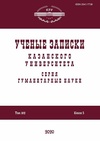Элементы разговорного языка в тексте переводного произведения Каюма Насыри «Абугалисина кыссасы»
Colloquial language elements in the translated version of Kayum Nasiri’s “Abugalisina kyssasy”
Author(s): Fler Foatovich GilemshinSubject(s): Historical Linguistics, Philology, Translation Studies, Turkic languages, Phraseology
Published by: Казанский (Приволжский) федеральный университет
Keywords: K. Nasyri; “Abugalisina kyssasy”; translated works; dukhtur; kyz; chapak; loanwords:
Summary/Abstract: This study explores how elements of the colloquial language are used in “Abugalisina kyissasy” (‘The Legend of Abugalisina’, ‘Abugalisina’) by Kayum Nasyri, a famous Tatar enlightener and ethnographer. To make it easier for his readers to understand the literary material, K. Nasyri used a number of effective techniques. Firstly, he defined all Arab-Persian words using the Tatar language: individual words, as well as figurative expressions and phrases were explained; he “duplicated” them with set phrases or phraseological units having a similar meaning in the Tatar colloquial language. The loanwords were both translated and followed by a synonym in the Tatar language: the Arab and Persian words are found in the characters’ speech, while the author’s speech provides their translations into the Tatar language. K. Nasyri skillfully inserts Tatar folk proverbs and sayings, figurative comparisons, and artistic metaphors into the text, thereby emphasizing particular places and strengthening the impact of the described events on the reader. All the above-described techniques contribute to the convergence of the language of K. Nasyri’s work with the folk and colloquial form of the Tatar language.
Journal: Ученые записки Казанского университета. Серия Гуманитарные науки
- Issue Year: 163/2021
- Issue No: 1
- Page Range: 93-100
- Page Count: 8
- Language: Russian

